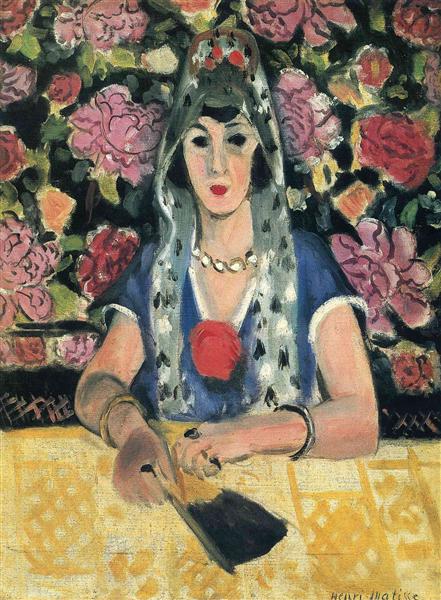Description
The painting "Spanish Woman: Harmony in Blue" by Henri Matisse, created in 1923, is a work that captures the essence of the artist's distinctive approach to color and form. Matisse, one of the greatest representatives of Fauvism, displays in this piece a vibrant symphony of blue tones that not only give the work its title but also create an atmosphere of serenity and contemplation.
The composition of "Spanish Woman: Harmony in Blue" is dominated by the central figure of a Spanish woman, whose attire and attitude evoke deep introspection. The woman is portrayed in a relaxed pose, sitting with crossed legs and a gaze that drifts outside the viewer's visual field. Her clothing, of an intense red, contrasts wonderfully with the predominantly blue background, further highlighting her figure and endowing it with palpable intimacy. This color contrast is very typical in Matisse's work, who always showed great interest in the simplification and purity of color.
Observing the work more closely, we can appreciate Matisse's treatment of color and brushstroke, which are characteristic of his late style. The use of flat, bright tones without an excess of detail allows for greater expressiveness and emphasizes the emotional strength of the painting. The brushstrokes are confident, decisive, facilitating a sense of fluidity and effortlessness in the execution of the work. Matisse knew the power of colors and used them to convey emotions and moods, and here, the harmony in blue is no exception.
The background of the painting is not merely a setting but an equally important element for the overall composition. The arabesque patterns that decorate the wall behind the woman suggest a certain Orientalist influence, which is not unusual in Matisse's work. These ornamental motifs, probably inspired by the textiles and ceramics he admired, complement the painting with a sense of exotic mystery and an almost musical beauty, given the rhythmic repetition of the visual components.
In the broader context of Matisse's work, "Spanish Woman: Harmony in Blue" represents a moment in his career where he had already internalized and distilled the principles of Fauvism, moving towards a simplicity that borders on the abstract but without abandoning figuration. This painting can well be compared with other works of the same period, such as "The Romanian Blouse" (1940), where the harmonious interaction of color and simple form and the female figure in its fullness can also be appreciated.
Henri Matisse is known for his mastery in capturing the essence of his subjects through a vibrant and poetic visual language. In "Spanish Woman: Harmony in Blue", the viewer is invited to immerse themselves in a world of contemplation where color dictates emotion, and the figure of the woman, with her serene expression, serves as the focal point of stillness and mystery. The work is a celebration of color and form that continues to resonate deeply with those who have the privilege of contemplating it.

